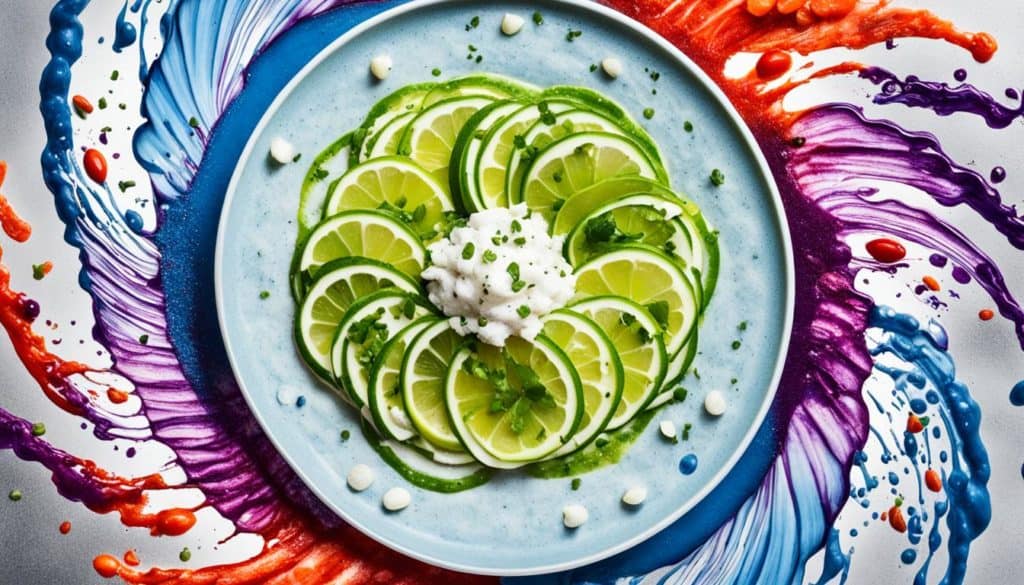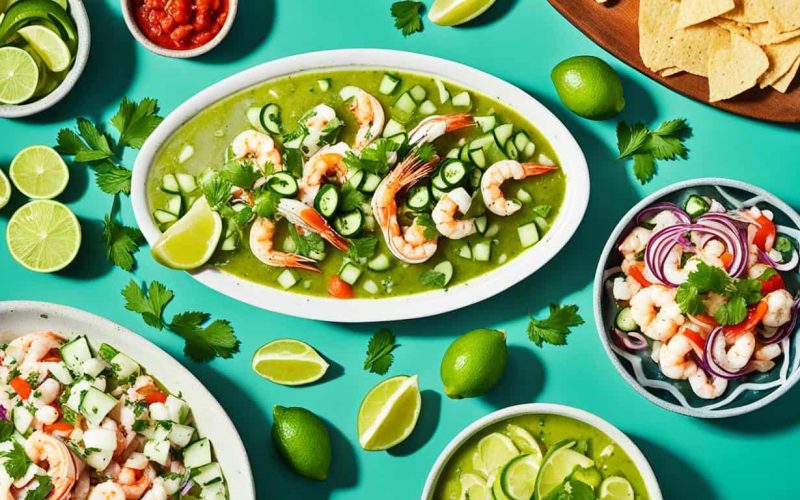Forget bland tuna salad, seafood lovers. We’re talking about a showdown between two titans of raw seafood finesse: aguachile and ceviche. Both tantalize with tangy citrus and a whisper of the sea, but beneath the surface, a fiery rivalry simmers. So, which reigns supreme – the chile-infused aguachile or the zesty ceviche?
Aguachile and ceviche are not just ordinary seafood dishes; they are the pride of Mexican cuisine, known for their vibrant flavors and refreshing appeal. These spicy seafood delicacies have gained popularity worldwide, enticing food enthusiasts with their unique preparations and distinct taste profiles.
Key Takeaways:
- Aguachile and ceviche are two popular Mexican seafood dishes known for their tangy citrus flavors.
- Aguachile is infused with chilies, giving it a spicy kick, while ceviche relies on tangy citrus juices for its zesty flavor.
- The ingredients and preparation methods of aguachile and ceviche vary, resulting in distinct taste profiles.
- Both dishes offer a refreshing taste of the sea and are popular choices for seafood lovers.
- Ultimately, the choice between aguachile and ceviche comes down to personal preference for spice and flavor intensity.
Head-to-Head Comparison
In this section, I will conduct a detailed head-to-head comparison between aguachile and ceviche. We will explore the key aspects that differentiate these two popular Mexican seafood dishes: ingredients, preparation, flavor profile, and presentation.
Ingredients
When it comes to the ingredients, both aguachile and ceviche share a base of fresh seafood. However, the specifics vary between the two.
Aguachile commonly features shrimp as the main ingredient, marinated in a vibrant concoction of lime juice, chili peppers, cilantro, and other spices. On the other hand, ceviche traditionally uses raw fish or seafood such as shrimp, white fish, or scallops, which are marinated in lime or lemon juice alongside onions, tomatoes, and cilantro.
Preparation
The methods of preparing aguachile and ceviche differ as well. Aguachile is known for its simplicity and speed in preparation. The shrimp is typically rinsed and then immediately bathed in the spicy marinade, allowing it to cook slightly in the acidic citrus juice.
In contrast, ceviche requires a longer marination process to allow the raw fish or seafood to fully cook in the lime or lemon juice. This slow cooking process gives ceviche a unique texture and flavor.
Flavor Profile
The flavor profiles of aguachile and ceviche offer distinct experiences for seafood enthusiasts.
Aguachile boasts a tangy, spicy, and refreshing taste. The lime juice contributes a bright acidity, while the chili peppers add a fiery kick. The combination of flavors creates a vibrant and invigorating dish.
Ceviche, on the other hand, offers a more delicate and balanced flavor. The citrus juices provide a tangy and acidic backdrop, complemented by the sweetness of onions and the earthiness of cilantro. It is a refreshing dish with a subtle spiciness.
Presentation
Both aguachile and ceviche are visually appealing dishes that showcase the beauty of fresh seafood.
Aguachile is typically served in a shallow bowl or plate, with the vibrant green marinade enveloping the shrimp. Garnishes such as sliced cucumbers, red onions, and avocado are often added to enhance its presentation.
Ceviche is often presented in a similar manner, with the marinated fish or seafood arranged on a plate or bowl. It is commonly adorned with colorful toppings like tomatoes, jalapeños, and cilantro, adding visual appeal to the dish.
Table: Ingredients, Preparation, Flavor Profile, and Presentation of Aguachile and Ceviche
| Aguachile | Ceviche | |
|---|---|---|
| Ingredients | Shrimp, lime juice, chili peppers, cilantro, spices | Raw fish/seafood, lime/lemon juice, onions, tomatoes, cilantro |
| Preparation | Quick marination, shrimp slightly cooked in citrus juice | Longer marination, raw fish/seafood fully cooked in citrus juice |
| Flavor Profile | Tangy, spicy, refreshing | Tangy, delicate, balanced |
| Presentation | Shallow bowl or plate with vibrant green marinade, garnished with cucumbers, onions, avocado | Arranged plate or bowl with marinated fish/seafood, topped with tomatoes, jalapeños, cilantro |
Aguachile vs. Ceviche: Savoring the Distinct Flavors
In this section, I will delve deeper into the distinct flavors of aguachile and ceviche. Starting with aguachile, the spicy sauce plays a crucial role in defining the dish’s signature flavor. Made from a blend of fresh chilies, citrus juices, and seasonings, aguachile sauce brings a fiery kick that tantalizes the taste buds and adds depth to the seafood.
On the other hand, ceviche delights with its vibrant combination of tangy and spicy flavors. The dish typically features a mix of seafood, such as shrimp or fish, marinated in citrus juices, onions, cilantro, and various seasonings. The result is a refreshing and zesty dish that perfectly balances acidity, heat, and the natural sweetness of fresh seafood.
Understanding Aguachile Sauce
A key component of aguachile, the spicy sauce is what gives the dish its distinct flavor. The sauce is typically made by blending or crushing fresh chilies, such as serrano or jalapeño, along with lime or lemon juice, garlic, and salt. Some variations may also include ingredients like cucumber or avocado, adding a refreshing twist to the sauce. The bold and vibrant flavors of aguachile sauce make it a standout element in this spicy seafood dish.
Discovering Ceviche Ingredients
Ceviche showcases the freshness of seafood and incorporates a delightful mix of ingredients. The primary ingredient is typically raw or cooked seafood, such as shrimp, fish, or scallops, which is then marinated in citrus juices like lime or lemon. Along with the seafood, ceviche commonly includes finely chopped onions, cilantro, chili peppers, and a touch of salt. These ingredients work together to create a medley of tangy, spicy, and savory flavors that make ceviche a beloved classic in Mexican cuisine.
Exploring Regional Variations in Mexican Seafood Dishes
Regional variations in Mexican seafood dishes add an extra layer of diversity to the flavors and ingredients. While aguachile and ceviche share similarities across regions, there are distinctive regional variations that make each dish unique. For example, in the coastal areas of Sinaloa, Mexico, aguachile is commonly prepared with shrimp and features a spicier sauce, while in the Yucatan Peninsula, ceviche may include ingredients like habanero peppers and tropical fruits, highlighting the regional flavors.

| Aguachile | Ceviche | |
|---|---|---|
| Flavor | Spicy and tangy | Tangy and spicy |
| Main Ingredient | Shrimp or fish | Seafood (shrimp, fish, scallops) |
| Sauce | Spicy sauce with chilies and citrus juices | Marinade of citrus juices, onions, cilantro, and seasonings |
| Regional Variations | Differ in spiciness and ingredient combinations across regions | May incorporate regional ingredients and flavors |
Verdict
After carefully evaluating the key differences and similarities between aguachile and ceviche, it’s time to reach a verdict. Deciding between these two spicy seafood dishes can be a tough choice, but understanding your flavor preferences and spice tolerance can help guide you in the right direction.
If you enjoy a tangy and citrus-forward flavor profile with a bit of heat, then ceviche might be the perfect choice for you. With its marinated fish and refreshing combination of ingredients, ceviche offers a vibrant and balanced taste that is adored by seafood enthusiasts around the world.
On the other hand, if you crave a bolder and spicier experience, aguachile takes the crown. The vibrant green aguachile sauce, packed with fresh chili peppers, offers a fiery kick that can awaken your taste buds like no other. If you’re a fan of intense spice and love experimenting with daring flavors, aguachile will be a thrilling choice.
Ultimately, the verdict boils down to personal preference. If you prefer a milder yet tangy taste, ceviche is the way to go. However, if the love for spice runs through your veins, aguachile will satisfy your cravings. No matter which dish you choose, both aguachile and ceviche offer a delightful blend of flavors and showcase the culinary creativity of Mexican cuisine.
So, the next time you find yourself deciding between aguachile and ceviche, trust your taste buds and embark on a memorable spicy seafood adventure.

Conclusion
Both aguachile and ceviche have carved their own path in Mexican cuisine, with regional variations adding an exciting twist to these beloved dishes. Choosing either the fiery kick of aguachile or the cool and citrusy notes of ceviche, you can be sure that you are indulging in a vibrant and authentic Mexican seafood experience.
Aguachile, with its vibrant and spicy sauce, tantalizes the taste buds with its bold flavors. The combination of fresh seafood and zesty ingredients creates a delightful explosion of heat and tang. On the other hand, ceviche impresses with its refreshing tanginess, showcasing the delicate flavors of perfectly marinated seafood.
So the next time you find yourself faced with the spicy seafood dilemma, I encourage you to embrace the opportunity to explore the world of aguachile and ceviche.
Take a bold culinary leap and savor the distinct flavors that have captivated food enthusiasts for generations. Whether you prefer the heat or a burst of tangy freshness, you will undoubtedly discover why the aguachile versus ceviche debate continues to ignite passionate conversations among seafood lovers.
FAQ
What is the difference between aguachile and ceviche?
Aguachile and ceviche are both spicy seafood dishes popular in Mexican cuisine. However, the main difference lies in the sauce used to marinate the seafood. Aguachile uses a spicy sauce made from lime juice, chili peppers, and cilantro, while ceviche typically incorporates a tangy marinade with lime juice, onions, and chili peppers.
What are the key ingredients in aguachile?
The key ingredients in aguachile include fresh seafood such as shrimp or fish, lime juice, chili peppers, cilantro, salt, and sometimes onions. The spicy sauce is made by blending the lime juice, chili peppers, and cilantro together.
What are the main ingredients used in ceviche?
Ceviche usually consists of fresh seafood like fish or shrimp, lime or lemon juice, onions, cilantro, chili peppers, and salt. The tangy marinade is made by combining the citrus juice, onions, and chili peppers.
How do you prepare aguachile?
To prepare aguachile, start by cleaning and deveining the shrimp or fish. Then, blend lime juice, chili peppers, cilantro, and salt to create the spicy sauce. Place the seafood in the sauce and let it marinate for several minutes. Serve chilled and garnish with additional cilantro and chili peppers if desired.
How do you make ceviche?
To make ceviche, begin by cleaning and dicing the fresh seafood. In a bowl, combine the seafood with lime or lemon juice, onions, cilantro, chili peppers, and salt. Let the mixture marinate in the refrigerator for at least 30 minutes, or until the seafood turns opaque and “cooked” in the citrus marinade. Serve chilled and garnish with additional onions and cilantro if desired.
What is the flavor profile of aguachile?
Aguachile has a bold, spicy flavor with tangy and citrusy notes from the lime juice. The combination of chili peppers and cilantro adds heat and freshness to the dish.
How does ceviche taste?
Ceviche offers a refreshing, tangy flavor profile. The citrus juice provides a bright and acidic taste, while the onions and chili peppers add a slight kick to the dish.
Are there regional variations in Mexican seafood dishes?
Yes, Mexican seafood dishes can vary across different regions. The flavor profiles, ingredients, and even the spicy levels can differ based on the specific region. Different coastal areas of Mexico may have their own unique take on aguachile and ceviche.
Which dish should I choose, aguachile or ceviche?
Choosing between aguachile and ceviche depends on your personal taste preferences. If you enjoy a spicier and more intense flavor, aguachile with its fiery sauce may be the right choice for you. On the other hand, if you prefer a tangy and refreshing dish, ceviche’s citrusy marinade might be more appealing. It’s best to try both and decide which one suits your palate the best.











One Response